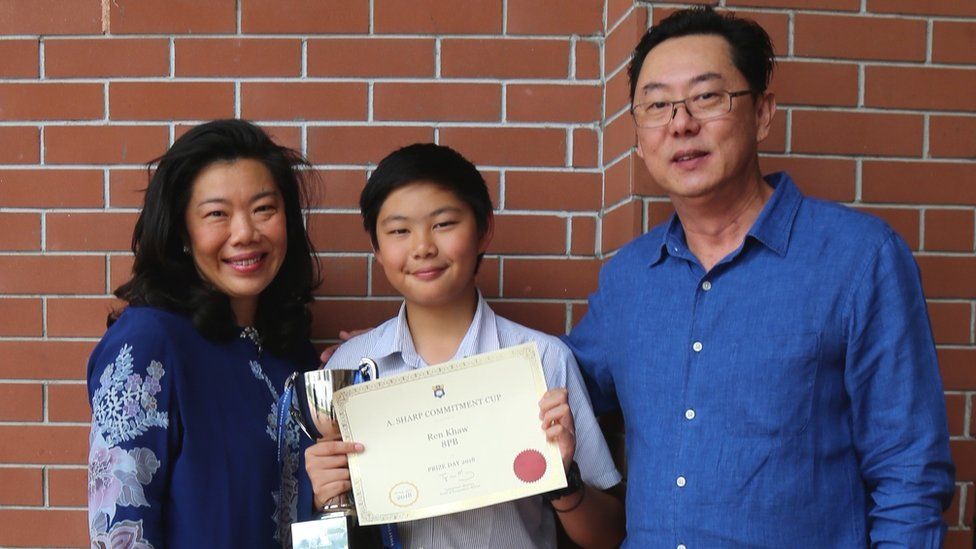How posh British schools are branching out in Asia
- Published

More than 40 years ago, Lyn Khaw traveled thousands of miles from her South East Asian home to study at a top UK school.
She says making the move aged 15 afforded her the valuable experience of living and learning independently.
Now, Mrs Khaw's son is getting the same opportunity, but without having to be so far from his family in Malaysia.
She is among the growing number of well-off parents in Asia sending their children to leading British schools that now have campuses in the region.
The schools - set up in South East Asian countries including Malaysia, Singapore and Thailand - have student accommodation on site and largely cater to Western families.
But they also admit locals who are able to pay as much as £36,000 ($47,000) a year to study and live at the schools.
People across South East Asia spent $80bn on private education last year, an increase from $60bn six years earlier, according to global accounting and consultancy firm EY.
EY expects spending, which has been stagnant since the pandemic began, to accelerate in the coming months.
"The British curriculum is well regarded, particularly in countries with historic ties with the UK such as Malaysia, Singapore and Thailand," said Luke Pais, EY's Asia Pacific private equity leader.
One top school with a presence in the region is Marlborough, where Catherine the Duchess of Cambridge and comedian Jack Whitehall were educated.
Marlborough, which is based in the English county of Wiltshire, opened its only overseas campus in the Malaysian city of Iskandar Puteri in 2012.
There, its facilities include an organic farm, a golf range, and a lake for water sports - features that are not usually found in local institutions.
The Khaws said Marlborough's Malaysian campus being relatively close to the family home in Kuala Lumpur is also one of the reasons for sending their 16-year-old son Ren there.
It is just a three-and-a-half-hour drive, or a 50-minute flight from the country's capital, which means he can easily go home for the holidays.
Sending him to the school does not come cheap though.
It costs the family MYR 200,400 ($47,466; £36,320) a year for him to board there. That is more than five times the average annual wage in Malaysia, according to the latest official figures.
Still, a quarter of the students at Marlborough College Malaysia are locals.
The hefty price of a British education for her son is worth it for Mrs Khaw, who has fond memories of her time at another leading British public school, Sherborne Girls in Dorset.
"There were obviously school rules, yet also a sense of personal freedom from taking the first steps to becoming independent," she said.
Meanwhile across the causeway in densely populated Singapore, Dulwich College has several sports fields, three swimming pools, and a performing arts centre with three theatres.
With its original location in south London, Dulwich's alumni includes the late Antarctic explorer Ernest Shackleton.
The school has branched out of the UK with 10 schools in Asia - the latest being in Yangon, Myanmar's largest city.
Another institution that has its sights on the region is Gordonstoun, the Scottish boarding school famous for its association with the British royal family.
It plans to open its first international school in China this year, with the ambition to expand in South East Asia in the coming years.
The Queen's late husband Prince Philip, their three sons - Charles, Andrew and Edward - as well their daughter Anne's two children were all educated at Gordonstoun.
Prince Charles famously made his views clear on the school's austere approach, describing it as "Colditz in kilts", in a reference to the World War Two German prisoner-of-war camp.
"The fact that we have educated three generations of the British Royal family, including the heir to the throne, is another attraction for families who want the best education possible for their child," Gordonstoun's principal Lisa Kerr told the BBC.
"We already welcome children from a variety of South East Asian countries to our campus here in Scotland but this option is not available or suitable for everyone," Ms Kerr said.
The schools often draw students from around the region.
Well-off parents in countries like Cambodia, for instance, prefer to send their children to the Asian outposts of leading British public schools as they feel confident that they will be taught English, an internationally recognised language, and other subjects to a high level, according to Kimkong Heng, a visiting senior research fellow at the Cambodia Development Center.
"Cambodia lags behind many countries in the region in terms of educational standards, research and innovation," Mr Heng told the BBC.
"It looks up to the Singaporean or Malaysian standards. And of course the goal is the European and American educational standards."
However, Mr Heng believes that attending a South East Asian branch of a top British school still does not completely match up to the experience of the original historic institutions.
"We dream to visit world-famous cities like London and study in world-renowned universities [there]. The standard of education is one thing, but the experience of the culture and language is another," he said.
Mr Pais said the lifting of travel restrictions around the world would benefit British public schools.
He added: "There are several attractive characteristics of South East Asia that supports the growth of private education - rising affluence, a favourable regulatory environment and limited high-quality supply."
You may also be interested in:
Why some parents send kids to outdoor schools
Related Topics
- Published26 March 2022
- Published24 March 2022